Speech Housing and the Economy

Ric Battellino
Deputy Governor
Remarks to the 6th National Housing Conference
Melbourne Convention and Exhibition Centre
Melbourne –
I have been asked to focus my comments on the economic aspects of housing. In keeping with this, I will start with a few words on the economy and then discuss the implications for the housing market. In the course of that, I would like to look at three specific questions:
- are we building enough dwellings?
- is there enough housing finance? and
- why are dwelling prices in Australia high relative to income?
The Economic Context
The Reserve Bank has published a lot of material on the global and Australian economies recently, including the November Statement on Monetary Policy, the minutes of Board meetings and various speeches.
I won't go over that material in detail, but it is worth drawing out a few highlights.
The first point is that the global economy is clearly growing again after some very sharp falls in activity late last year and early this year (Graph 1). Virtually all economies recorded growth in the September quarter, and the information available so far for the December quarter indicates that the expansion has since continued.
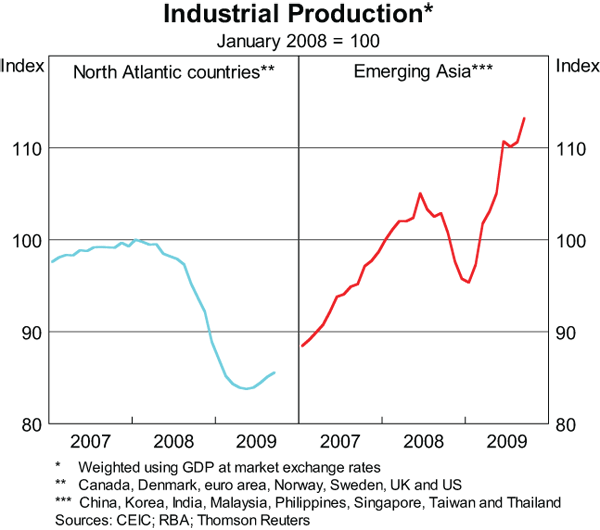
It is also clear that the economies of the North Atlantic are lagging behind those in other parts of the world, particularly those in Asia where the economic recovery has been quite rapid. It is not surprising that the North Atlantic economies are lagging, as they were at the centre of the financial crisis. Many of the banks in that region are still at the early stages of balance sheet repair, which is limiting their capacity to lend.
Banks elsewhere are in much better shape. While they were caught up in the squeeze on global money markets that flowed from the events in the United States late last year, they generally did not experience severe credit losses. Once the liquidity pressures passed, financial intermediation in these countries has tended to normalise. This is certainly the case in the Asian region. More generally, economies in the Asian region have responded well to accommodative macroeconomic policies and economic activity has rebounded.
This is positive for Australia as Asian countries are our major trading partners. While the world economy as a whole is forecast to remain relatively sluggish next year, economic growth for the group of countries that comprise our major trading partners is expected to recover to a relatively normal pace.
Some commentators question the capacity of Asia to continue to grow if the developed economies of the North Atlantic remain weak. While there is no doubt that weakness in the developed economies would have an adverse effect on Asia's growth prospects, we should not lose sight of the fact that most of the growth in the larger Asian economies comes from their own domestic demand. In the case of China, for example, domestic demand contributed on average close to 9 percentage points per annum to growth over the past decade, while net exports contributed about 1 percentage point (see Table 1). Importantly, the authorities in most of these countries have plenty of scope to pursue policies that sustain domestic demand.
| Annual Average Growth 1999–2008 (%) |
Contribution from: | |||
|---|---|---|---|---|
| Domestic demand (% points) |
Net exports (% points) |
|||
| Japan | 1.3 | 0.9 | 0.4 | |
| China | 9.7 | 8.7 | 1.1 | |
| India | 7.1 | 7.5 | −0.4 | |
| Korea | 5.2 | 4.5 | 0.7 | |
| Indonesia | 4.7 | 4.1 | 0.6 | |
| Taiwan | 3.8 | 1.6 | 2.3 | |
| Singapore | 5.6 | 4.6 | 1.4 | |
* This calculation abstracts from the fact that some of the growth of domestic demand has come from increased export income. Sources: CEIC; Thomson Reuters; RBA |
||||
The Australian economy in 2009 has held up much better than had been expected earlier in the year. Australia is the only developed economy where year-ended growth in GDP has remained positive during the past year. It is now 18 years since Australia has experienced a negative in year-ended GDP growth, a very prolonged economic expansion (Graph 2). With the economy having only recently entered a new upswing, it is reasonable to assume that we will see this growth extended for a few more years yet.
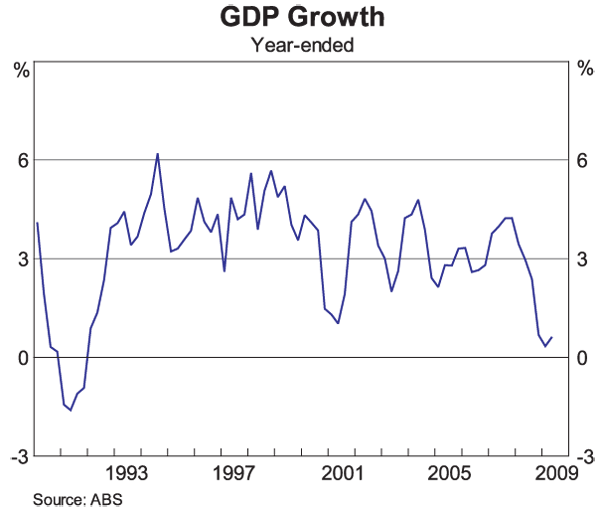
Over the next few years, Australia is also expected to see a further expansion of the resources sector, including the development of some very large gas projects. Mining investment, which is already at record levels as a share of GDP, could rise substantially further in the next five years or so (Graph 3).
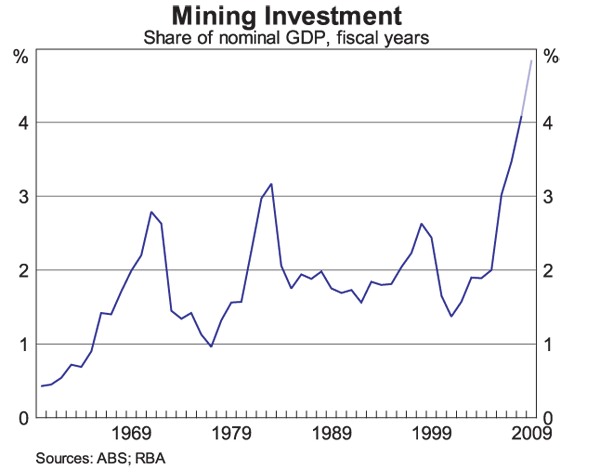
If this scenario eventuates, it will have powerful and broad-ranging implications for the economy. Glenn Stevens and Ken Henry have addressed these recently. I won't go over all that ground again today but, as far as the housing market is concerned, the key implications are that:
- the rate of growth in the population, which has already picked up in recent years, is likely to remain strong, as demand for labour will encourage continued high immigration;
- household incomes are likely to rise solidly, which will help underpin the demand for housing; and
- the construction industry is likely to face substantial competition for workers from the mining sector.
While this suggests a generally positive environment for the housing sector, it will not be without its challenges.
Are We Building Enough Dwellings?
As Glenn Stevens mentioned recently, one of the key challenges will be to ensure that the supply of housing is able to respond adequately to the increased demand for accommodation. There is a broad consensus that in recent years Australia has not built enough dwellings. A good indication of this is the very low vacancy rates in rental markets.
This shortfall in housing, however, is not because, as a nation, we have cut back on investment in dwellings. In fact, the opposite is true: over the past decade dwelling investment has been higher – around 6 per cent of GDP – than it has typically been in the past (Graph 4).
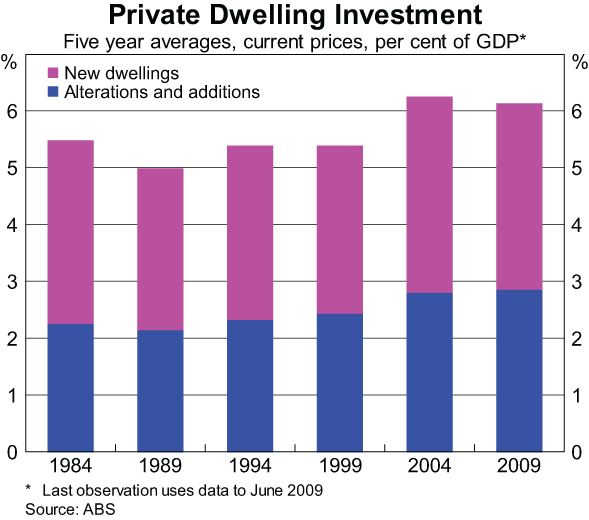
So how do we square up the seemingly contradictory evidence that overall investment in housing is relatively high, yet there seems to be a shortage of dwellings? I think four factors help to explain this contradiction.
-
First, Australians are on average spending a lot more on each new dwelling. Real
expenditure on each new dwelling built is now 60 per cent higher than
it was around 15 years ago (Graph 5). This is due to improvements
in quality and increases in size.
Graph 5
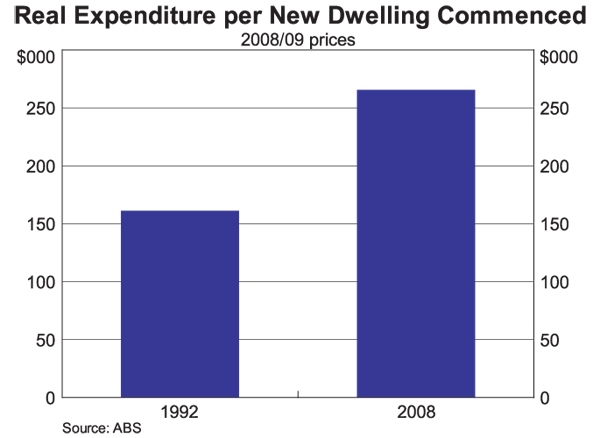
- Second, a high proportion of dwelling investment is in the form of alterations and additions – i.e. upgrading existing houses rather than building new ones. Almost half of all dwelling investment has been accounted for by alterations and additions in recent years.
- Third, a higher proportion of the new houses built are simply replacing existing houses that have been demolished. We estimate that between 2001 and 2006, around 15 per cent of new houses built replaced houses that had been demolished; 10–15 years earlier, that figure was less than 10 per cent.
- Fourth, a significant proportion of dwelling investment appears to have gone into holiday homes or second homes. Census data show that the number of dwellings built has exceeded the increase in the number of households by a large margin. As a result, the ratio of the number of dwellings to the number of households has been rising over time; as at 2006, there were 8 per cent more dwellings in Australia than there were households. Presumably, most of this surplus reflects holiday houses and second houses (Graph 6).
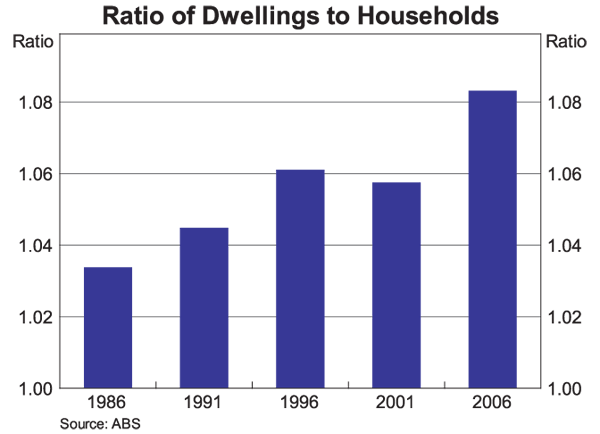
In short, the apparent contradiction between the shortage of dwellings and the high investment in dwellings arises because a high proportion of dwelling investment is going into improving the quality of existing dwellings and building accommodation additional to primary residences. If as a nation we want to continue to do this, while at the same time providing enough dwellings for the growing population, the overall amount of dwelling investment undertaken will need to increase relative to GDP. That would raise important challenges for the housing industry in terms of its capacity to meet that demand. It would, of course, also raise the question of which of the other expenditure components of GDP should bear the offsetting fall in share.
Is There Enough Housing Finance?
Let me now turn to the question of housing finance.
Over the past couple of years, there has been a significant change in the structure of the housing finance market, with lenders that were funding themselves through securitisation cutting back substantially on their new lending. Increases in the cost of funds for these lenders made it largely uneconomic for them to lend. Their declining market share has been picked up by the major banks, which now account for about 80 per cent of all new housing loans.
These developments have led to concerns that borrowers may not have sufficient access to loans or that the cost of new loans may increase. However, to date at least, the evidence does not suggest that we should be overly concerned.
On the question of cost, margins on standard housing loans have, if anything, narrowed a little over the past couple of years, even for the major banks. Two years ago, the interest rates charged by the major banks on new variable-rate housing loans were about 190 basis points above their cost of funds. The margin today is slightly narrower. To the extent that there has been a widening in banks' margins it has been on their business lending. So far, it appears that there is still sufficient competition in the housing loan market for lenders not to have been able to widen their margins.
The Government has helped to sustain that competition by putting in place arrangements to encourage the continued securitisation of housing loans. The Australian Office of Financial Management (AOFM) has been buying mortgage-backed securities from these lenders at yields that, during the crisis, were well below those in the secondary market (though still very attractive in absolute terms). This helped keep the cost of funds to these firms at levels that allowed them to continue lending, albeit at a much reduced rate from that of earlier years. The Government has recently announced an expansion in the AOFM program. At the same time, issuers of mortgage-backed securities are finding that, with market spreads having narrowed substantially in recent months, it is again becoming economic to issue securities into the market.
As my colleague, Guy Debelle, said last week, the Australian securitisation market, like securitisation markets everywhere, has suffered reputational damage from the events in the United States. However, Australian mortgage-backed securities have not experienced credit problems. I am confident that this fundamental point will eventually see the local securitisation market return to being an important source of funding for housing loans.
In the meantime, increased lending by banks means that total new loan approvals are relatively high. In fact, new loan approvals are at levels which indicate a degree of home-buyer activity that has typically been associated with rising house prices (Graph 7). At the same time, however, existing borrowers are continuing to take advantage of the low level of interest rates to make accelerated loan repayments, which is restraining the overall growth of housing credit. Even so, housing credit is growing at an annual rate of 7–8 per cent, a pace which is more than adequate to fund the new investment in housing that is needed.
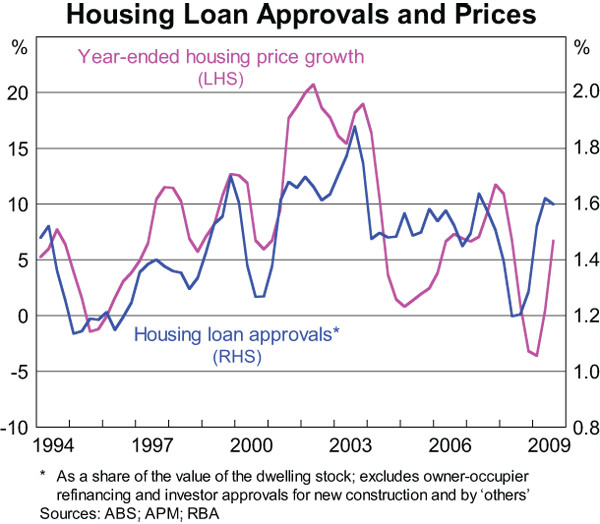
Why are Dwelling Prices High in Australia Relative to Income?
There is a common perception that house prices relative to household income in Australia are high both compared with other countries and with our own history.
It is certainly the case that the ratio of house prices to income in Australia is higher now than it was 20 years ago. However, this is largely explained by the fact that the fall in inflation over that period has allowed nominal interest rates to cycle around a lower average level now than was the case earlier. That is, lower interest rates have allowed households to take out bigger home loans, without increasing housing loan repayments (Graph 8). In turn this has given households more buying capacity in the housing market, which has been reflected in house prices.
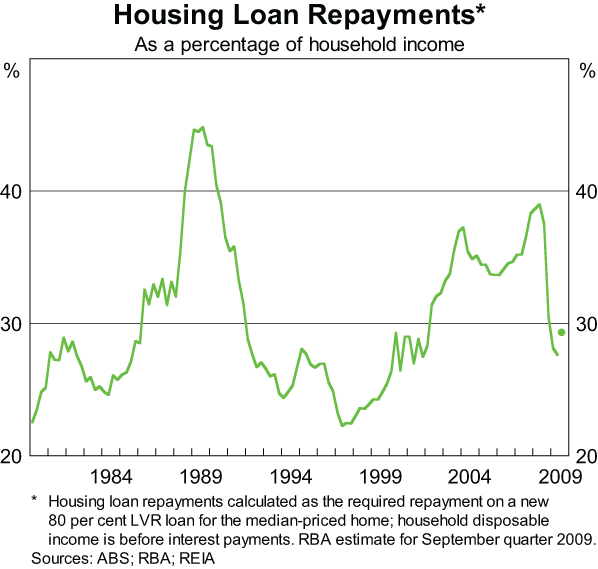
International comparisons of the relativity between house prices and income have been the subject of considerable research over the years. One of the complications faced by people working on this topic is to ensure consistency in the data that underlie the comparisons. Do the figures relate to capital city prices, or the prices across the whole country? Do they cover all dwellings or just detached houses? Is income measured as average weekly earnings or average household income? It is not always possible to get entirely consistent data across countries, so we need to be careful in interpreting the results of these comparisons.
Most people do agree, however, that the ratio of house prices to incomes in Australia is higher than in the United States. One explanation that has been put forward for this is that the Australian population is more concentrated in a few large cities, where house prices are higher, even relative to income. This seems like a plausible explanation, but there must also be a financial explanation, otherwise we would expect to observe that housing stress among Australians was higher than in the United States, and this is clearly not the case. Arrears rates on housing loans in Australia have typically been lower than those in the United States, despite the higher ratio of house prices to income.
There are a couple of reasons why Australian households seem to be able to sustain a higher ratio of house prices to income. First, Australians seem to spend less of their income on non-housing consumption than is the case for US households, with a significant part of this difference explained by lower health costs in Australia. Australian households therefore have greater capacity to service housing loans. Second, the level of gearing in the United States housing market is noticeably higher than in Australia. This may reflect the fact that Australian households are more active in paying down their loans after buying a home, possibly because owner-occupied mortgage interest rates are not tax deductible here as they are in the United States. The faster pay-down of mortgage debt in Australia reduces the risk of borrowers subsequently getting into financial difficulty.
Overall, the experience of the last few years suggests that the Australian household sector as a whole appears to have the financial capacity to sustain a relatively high ratio of house prices to income. That capacity may not, however, be evenly distributed through the population. Many 50–60 year olds, having benefited from the prolonged economic expansion over almost 20 years and the accumulation of superannuation savings, are in a strong financial position. This has encouraged a change in financial behaviour, with many households in this group being more inclined to stay geared up later in life, using the funds to upgrade or expand dwelling investments. It is likely that this changed behaviour has been a significant factor in the housing developments we have seen over the past 10–15 years.
In contrast, the typical first-home owner cohort – those under 35 years of age – has experienced a noticeable decline in home ownership over the past 10–15 years (Graph 9). It may be that this is being driven by demographic factors – such as the fact that young people are staying in education longer and delaying the formation of new households – but it may also be financially driven.
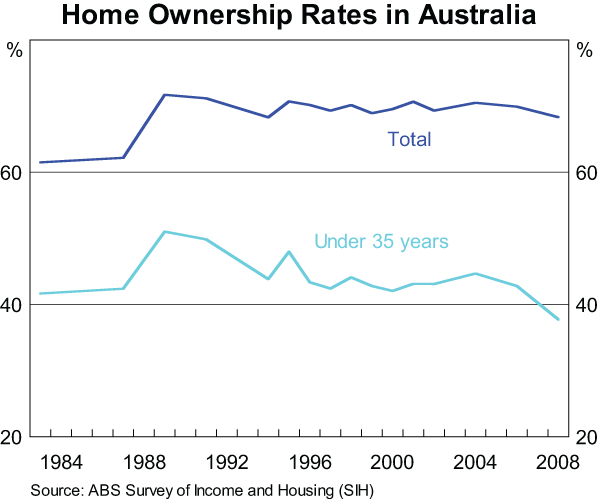
A particular problem for first-home owners is that the rise in the ratio of house prices to income has substantially increased the deposit needed to get into the market. On plausible assumptions, the deposit needed by first-home owners may now be around one and a quarter years' income, almost twice what it was 15 years ago. At one stage, lenders were responding to this by lowering the deposit requirement, but this carried the risk of buyers subsequently getting into difficulty. Also, various governments have sought to provide concessions to first-home owners through grants or tax relief. However, while these measures assist the first wave of buyers who are able to take advantage of them, the benefits diminish over time to the extent that these concessions become capitalised into higher house prices.
Conclusion
I am conscious that I have raised a lot of issues and provided very few answers. Nonetheless, I will stop here, and leave it for your discussions over the next couple of days to resolve some of these issues.